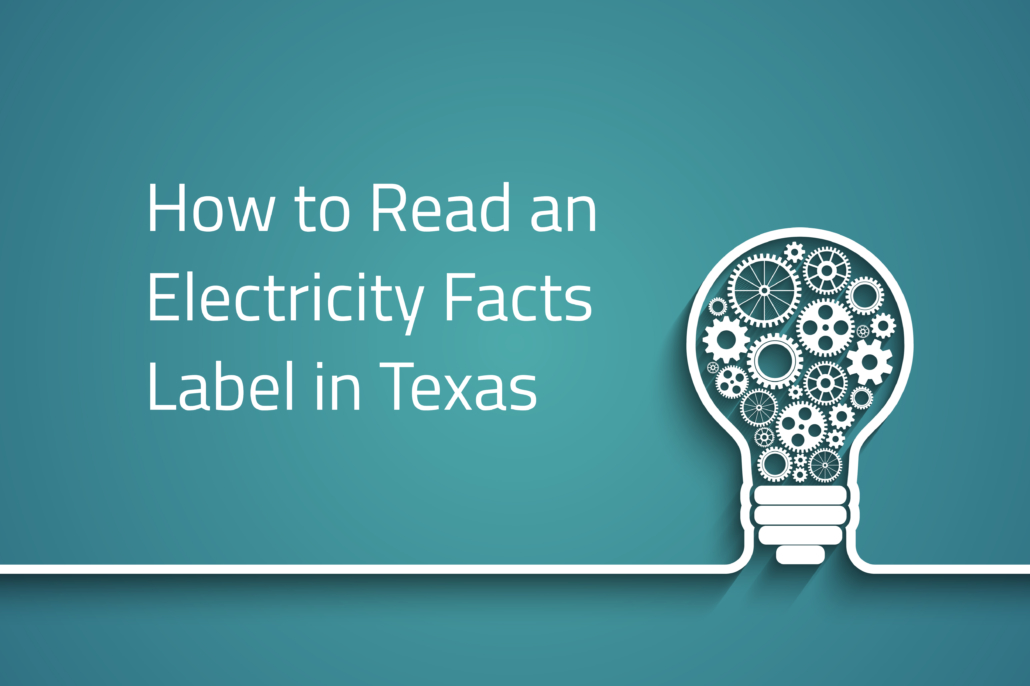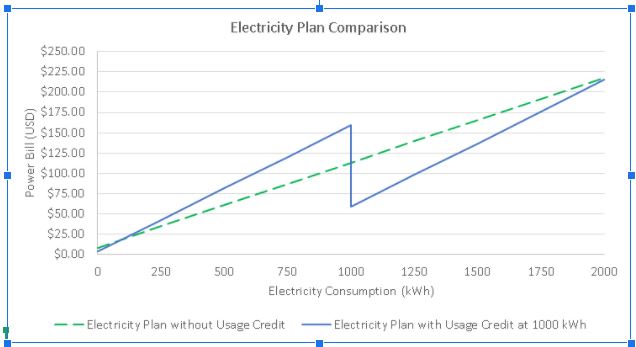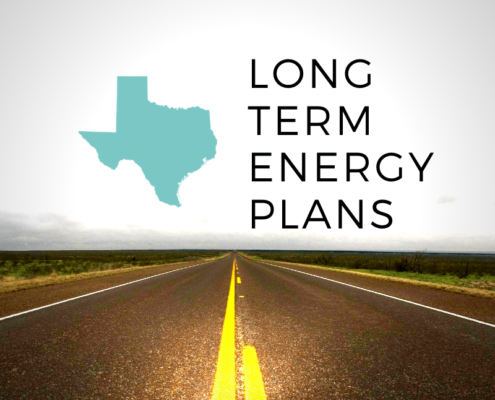Last Updated on May 22, 2022 by Mary Pressler

What’s an Electricity Facts Label?
Since Texas has a deregulated energy sector, there is a wide range of electricity plans available. Choosing your electricity provider is beneficial when you can find a plan that lowers your power bill. However, some electricity plans have confusing prices and conditions, and you can end up paying much more than expected.
The Public Utility Commission of Texas (PUCT) created the Electricity Facts Label (EFL) to protect consumers from misleading information. The EFL is similar to the Nutrition Facts of food and beverages, which provide an exact description of what you are consuming. However, an EFL is only useful when interpreted correctly, and this article will provide a detailed guide.
There are important differences between electricity plans. However, an EFL normally starts with a heading that contains the following information:
- Name of the Retail Electricity Provider or REP
- Name of the electricity plan, since the same provider may offer different plans
- Transmission and Distribution Utility (TDU) in your service area
- Effective date
Most electricity consumers in Texas deal with two types of companies. The Retail Electricity Provider (REP) is the company that sells you the energy, while the Transmission and Distribution Utility (TDU) is the company that delivers energy with power lines, transformers and utility poles.
For example, Rhythm Energy and Payless Power are REPs, while Oncor and CenterPoint are TDUs. You can choose your energy provider among the options available for your ZIP code, but the TDU is set based on your location.
The EFL Shows Pricing in Three Tiers
When comparing electricity plans in Texas, you will notice there are three electricity prices at three consumption levels – 500 kWh, 1000 kWh and 2000 kWh. The following is an example:
| Average Monthly Use | 500 kWh | 1,000 kWh | 2,000 kWh |
| Average Price per kWh | 12.2¢ | 11.3¢ | 10.9¢ |
Contrary to popular belief, these are not electricity rates. Instead, these numbers represent the average kWh price at that consumption level, after adding all the corresponding charges. To demonstrate how this works, consider an electricity plan with the following conditions:
- The REP charges a fixed fee of $4.95, and 6.9¢ per kWh
- The TDU charges a fixed fee of $3.42 and 3.578¢ per kWh
In this case, you pay a total fixed fee of $8.37, and a total energy charge of 10.478¢ per kWh. When the power bill is calculated at several usage levels, you will notice that the average price per kWh decreases with consumption.
| Electricity
Consumption |
Fixed Charge | Energy Charge | Total Charge | Average
kWh Price |
| 250 kWh | $8.37 | $26.20 | $34.57 | 13.8¢ |
| 500 kWh | $8.37 | $52.39 | $60.76 | 12.2¢ |
| 750 kWh | $8.37 | $78.59 | $86.96 | 11.6¢ |
| 1000 kWh | $8.37 | $104.78 | $113.15 | 11.3¢ |
| 1250 kWh | $8.37 | $130.98 | $139.35 | 11.1¢ |
| 1500 kWh | $8.37 | $157.17 | $165.54 | 11.0¢ |
| 1750 kWh | $8.37 | $183.37 | $191.74 | 11.0¢ |
| 2000 kWh | $8.37 | $209.56 | $217.93 | 10.9¢ |
The electricity tariff does not change at 500, 1000 and 2000 kWh. The average kWh price changes as a consequence of how the power bill is calculated, which combines fixed and variable charges. However, the electric tariff itself is already set, as described by the EFL.
The average kilowatt-hour prices in an EFL would only apply if you consumed the exact kWh amounts displayed. These prices give you an idea of what to expect, but some electricity plans have conditions that are not evident. For example, you may notice that some plans offer a very low price at 1000 kWh, such as the following example:
| Average Monthly Use | 500 kWh | 1,000 kWh | 2,000 kWh |
| Average Price per kWh | 16.3¢ | 5.9¢ | 10.7¢ |
The price of 5.9¢ per kWh may seem like a great deal. However, when you look at the full EFL, you may find information like the following:
- The REP charges 12¢ per kWh, without a fixed fee
- There is a credit of $100 for consuming at least 1,000 kWh
- The TDU charges a fixed fee of $3.42, and 3.578¢ per kWh
A power bill of $59 for 1,000 kWh may seem like a good deal, but you will have to pay much more if your consumption falls short of 1,000 kWh. For example, assume you miss the mark by 50 kWh, and your measured consumption is 950 kWh. In this case, you don’t get the $100 credit, and your payment is the following:
- REP charge = 950 kWh x $0.12/kWh = $114
- TDU charge = $3.42 + 950 kWh x $0.03578/kWh = $37.41
- Total charge = $114 + $37.41 = $151.41
- Average kWh price = $151.41 / 950 kWh = $0.159/kWh = 15.9¢ / kWh
The following table shows how your power bill drops between 999 and 1,000 kWh. An electricity plan with a minimum usage credit is only recommended if you are completely sure that your consumption stays above the minimum.
| Electricity
Consumption |
Fixed Charge | Energy Charge | Min. Usage Credit | Total Charge | Average
kWh Price |
| 250 kWh | $3.42 | $38.95 | $0.00 | $42.37 | 16.9¢ |
| 500 kWh | $3.42 | $77.89 | $0.00 | $81.31 | 16.3¢ |
| 750 kWh | $3.42 | $116.84 | $0.00 | $120.26 | 16.0¢ |
| 999 kWh | $3.42 | $155.62 | $0.00 | $159.04 | 15.9¢ |
| 1000 kWh | $3.42 | $155.78 | -$100.00 | $59.20 | 5.9¢ |
| 1250 kWh | $3.42 | $194.73 | -$100.00 | $98.15 | 7.9¢ |
| 1500 kWh | $3.42 | $233.67 | -$100.00 | $137.09 | 9.1¢ |
| 1750 kWh | $3.42 | $272.62 | -$100.00 | $176.04 | 10.1¢ |
| 2000 kWh | $3.42 | $311.56 | -$100.00 | $214.98 | 10.7¢ |
If you were expecting a bill close to $59, but your consumption was slightly below 1,000 kWh, you will end up paying much more. The following graph compares the two electricity plans in this example, showing how the power bill behaves from 0 to 2,000 kWh.
 Based only on the electricity price offered at 1,000 kWh, the second example (blue) may seem like a better deal. However, when the EFL is analyzed carefully, you can save hundreds of dollars with better decisions.
Based only on the electricity price offered at 1,000 kWh, the second example (blue) may seem like a better deal. However, when the EFL is analyzed carefully, you can save hundreds of dollars with better decisions.
A home that consumes around 1,000 kWh per month would have a very predictable power bill with the first electricity plan (green). However, the power bill would be very unpredictable with the second electricity plan (blue). Power bills would be much higher when consumption falls below 1,000 kWh, and much lower when consumption exceeds 1,000 kWh.
A small apartment consuming around 500 kWh would achieve consistent savings with the first electricity plan (green). The $100 usage credit at 1,000 kWh provides no benefit if the consumption is always below that value. Switching to the second electricity plan (blue) would be a bad decision here, as the graph shows.
The opposite would apply for a large home that consumes above 1,500 kWh every month. In this case, the homeowner always gets the $100 credit, keeping the average kWh price low. Switching from the second plan (blue) to the first plan (green) would increase power bills for this consumer.
Additional Information You Must Check in the EFL
When choosing an electricity plan, the power bill amount is determined mostly by the calculation procedure and your average consumption. However, the EFL has additional information you should review. This gives you a better idea of your expected power bills, and you can also avoid hidden costs and other unpleasant surprises.
Typically, a reliable electricity provider will not mislead customers. If you find an EFL that is very confusing, the provider is probably trying to charge you more by using complex conditions.
Type of Rate
Does the electricity plan have a fixed, variable or indexed rate? In a fixed-rate plan, the electricity provider will not change the kWh price for the entire contract duration. On the other hand, you can expect price increases and decreases in variable or indexed-rate plans. Typically, you will be charged low during winter and high during summer.
Keep in mind that the TDU delivery charge can change even in a fixed-rate plan, since that part of the kWh price is set by the utility company (TDU) in your service area. In other words, the electricity provider you choose has no control over this part of the power bill. These charges are reviewed and adjusted twice per year, in March and September.
Contract Term
This is the contract duration associated with the electricity plan. Fixed-rate plans normally have terms of 12, 24 or 36 months, while variable and indexed-rate plans normally last for one month.
Is There a Termination Fee?
This is the penalty you must pay for switching your electricity plan before the end of the contract. Generally, this applies for fixed-rate plans, which have a long contract term. Variable and indexed-rate electricity plans normally last for only one month, but make sure you double-check the Electricity Facts Label.
For example, if you have a 12-month contract with a $120 termination fee, and you want to change your electricity plan after 10 months, you must pay $120 to leave the current plan.
Can the kWh Price Change During the Contract Period?
As mentioned above, one part of the kilowatt-hour price is set by the REP, and another part is set by the local TDU company. The TDU charges can change regardless of your electricity plan, while the REP charges are only adjusted in variable and indexed-rate plans. The EFL must explain all the conditions that may change your kWh price.
You can expect smaller price variations in a fixed-rate plan, since only the TDU part of the kWh price can vary. These charges are adjusted twice per year, which means your final price is stable for six-month intervals – March to September, and September to March.
Is This a Prepaid Electricity Plan?
As their name implies, prepaid electricity plans are paid in advance, and the energy consumed is deducted from your balance. Getting approved for prepaid electricity is easier, since they have less requirements – many providers do not ask for a credit record, for example. However, prepaid electricity plans also tend to be more expensive.
Does the REP Purchase Surplus Renewable Energy?
This condition is important if you have solar panels, wind turbines, or any renewable energy system at home. Some electricity plans let you sell surplus generation, which is deducted from your power bill. On the other hand, if the REP does not purchase renewable energy from consumers, you must consume all the electricity you produce on site.
Renewable Energy Content
The Electricity Facts Label will specify what percentage of the electricity purchased comes from renewable sources, and how this compares with the Texas average. While this does not affect the kWh price, it is useful information if you want a provider that uses a high percentage of renewable energy. In fact, there are electricity plans with 100% renewable energy available.
Conclusion – Make Sure You Read the EFL Carefully
This guide summarizes the information you will find in most Electricity Facts Labels. However, some electricity plans may include unusual charges and conditions that can work against you if you are not careful. Disclosing all the information about an electricity plan is a legal requirement from the PUCT. Consider that the EFL may reference the Terms of Service, so make sure you also check them before choosing an electricity plan.









